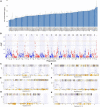Cardiac copper content and its relationship with heart physiology: Insights based on quantitative genetic and functional analyses using BXD family mice
- PMID: 36818345
- PMCID: PMC9931904
- DOI: 10.3389/fcvm.2023.1089963
Cardiac copper content and its relationship with heart physiology: Insights based on quantitative genetic and functional analyses using BXD family mice
Abstract
Background: Copper (Cu) is essential for the functioning of various enzymes involved in important cellular and physiological processes. Although critical for normal cardiac function, excessive accumulation, or deficiency of Cu in the myocardium is detrimental to the heart. Fluctuations in cardiac Cu content have been shown to cause cardiac pathologies and imbalance in systemic Cu metabolism. However, the genetic basis underlying cardiac Cu levels and their effects on heart traits remain to be understood. Representing the largest murine genetic reference population, BXD strains have been widely used to explore genotype-phenotype associations and identify quantitative trait loci (QTL) and candidate genes.
Methods: Cardiac Cu concentration and heart function in BXD strains were measured, followed by QTL mapping. The candidate genes modulating Cu homeostasis in mice hearts were identified using a multi-criteria scoring/filtering approach.
Results: Significant correlations were identified between cardiac Cu concentration and left ventricular (LV) internal diameter and volumes at end-diastole and end-systole, demonstrating that the BXDs with higher cardiac Cu levels have larger LV chamber. Conversely, cardiac Cu levels negatively correlated with LV posterior wall thickness, suggesting that lower Cu concentration in the heart is associated with LV hypertrophy. Genetic mapping identified six QTLs containing a total of 217 genes, which were further narrowed down to 21 genes that showed a significant association with cardiac Cu content in mice. Among those, Prex1 and Irx3 are the strongest candidates involved in cardiac Cu modulation.
Conclusion: Cardiac Cu level is significantly correlated with heart chamber size and hypertrophy phenotypes in BXD mice, while being regulated by multiple genes in several QTLs. Prex1 and Irx3 may be involved in modulating Cu metabolism and its downstream effects and warrant further experimental and functional validations.
Keywords: BXD; cardiac Cu homeostasis; cardiomyopathy; gene expression; genetic mapping; hypertrophy; quantitative trait loci; systems genetics.
Copyright © 2023 Bajpai, Gu, Orgil, Xu, Torres-Rojas, Zhao, Chen, Starlard-Davenport, Jones, Lebeche, Towbin, Purevjav, Lu and Zhang.
Conflict of interest statement
The authors declare that the research was conducted in the absence of any commercial or financial relationships that could be construed as a potential conflict of interest.
Figures




Similar articles
-
Echocardiography phenotyping in murine genetic reference population of BXD strains reveals significant QTLs associated with cardiac function and morphology.Physiol Genomics. 2023 Feb 1;55(2):51-66. doi: 10.1152/physiolgenomics.00120.2022. Epub 2022 Dec 19. Physiol Genomics. 2023. PMID: 36534598 Free PMC article.
-
Identifying modifier genes for hypertrophic cardiomyopathy.J Mol Cell Cardiol. 2020 Jul;144:119-126. doi: 10.1016/j.yjmcc.2020.05.006. Epub 2020 May 26. J Mol Cell Cardiol. 2020. PMID: 32470469 Free PMC article.
-
Unraveling the genetic blueprint of doxorubicin-induced cardiotoxicity through systems genetics approaches.Cardiooncology. 2025 Jun 3;11(1):53. doi: 10.1186/s40959-025-00349-y. Cardiooncology. 2025. PMID: 40462234 Free PMC article.
-
Development of a murine model for aerosolized ebolavirus infection using a panel of recombinant inbred mice.Viruses. 2012 Dec 3;4(12):3468-93. doi: 10.3390/v4123468. Viruses. 2012. PMID: 23207275 Free PMC article. Review.
-
Quantitative trait locus (QTL) mapping in aging systems.Methods Mol Biol. 2007;371:321-48. doi: 10.1007/978-1-59745-361-5_23. Methods Mol Biol. 2007. PMID: 17634591 Review.
Cited by
-
Systems genetics identifies methionine as a high risk factor for Alzheimer's disease.Front Neurosci. 2024 Jul 16;18:1381889. doi: 10.3389/fnins.2024.1381889. eCollection 2024. Front Neurosci. 2024. PMID: 39081851 Free PMC article.
-
Comprehensive analysis of geographic and breed-purpose influences on genetic diversity and inherited disease risk in the Doberman dog breed.Canine Med Genet. 2023 Jun 5;10(1):7. doi: 10.1186/s40575-023-00130-3. Canine Med Genet. 2023. PMID: 37277858 Free PMC article.
-
Cuproptosis and Cu: a new paradigm in cellular death and their role in non-cancerous diseases.Apoptosis. 2024 Oct;29(9-10):1330-1360. doi: 10.1007/s10495-024-01993-y. Epub 2024 Jul 16. Apoptosis. 2024. PMID: 39014119 Review.
References
-
- Zoroddu MA, Aaseth J, Crisponi G, Medici S, Peana M, Nurchi VM. The essential metals for humans: a brief overview. J Inorg Biochem. (2019) 195:120–9. - PubMed
Grants and funding
LinkOut - more resources
Full Text Sources
Molecular Biology Databases

